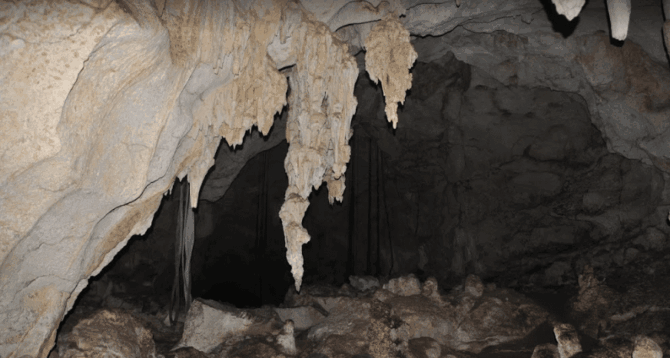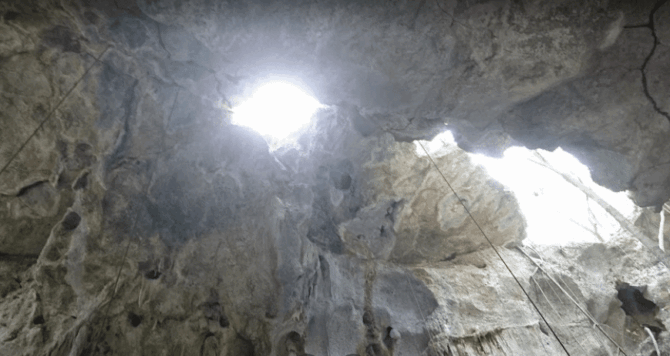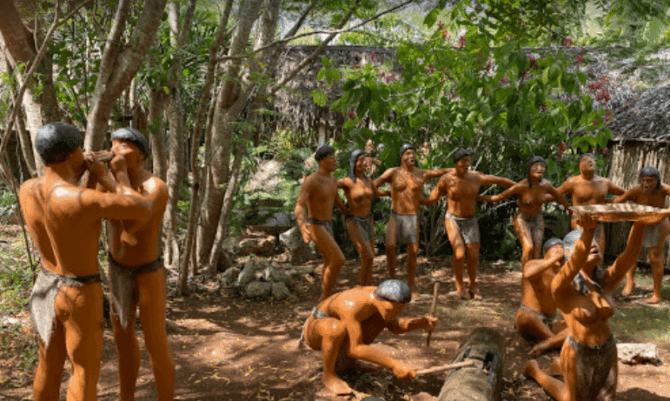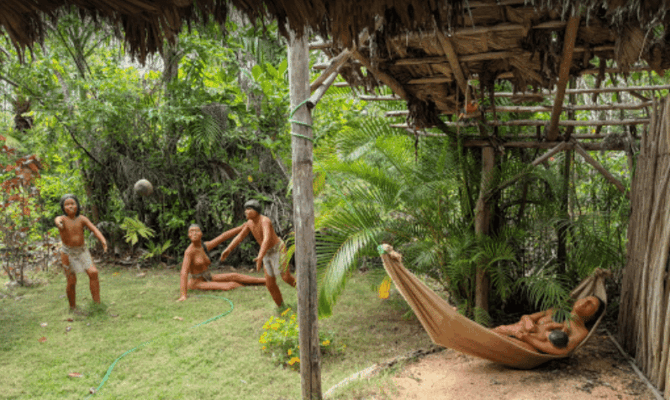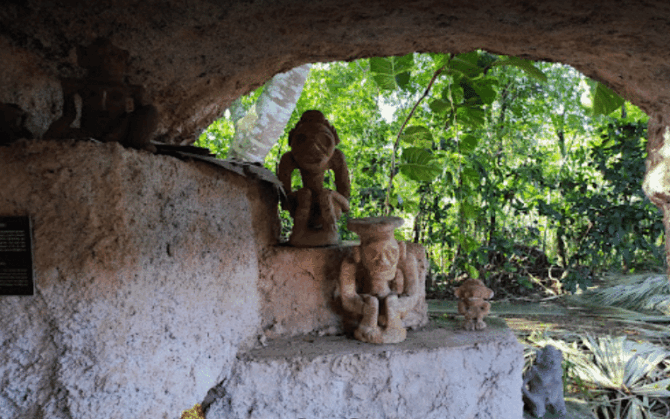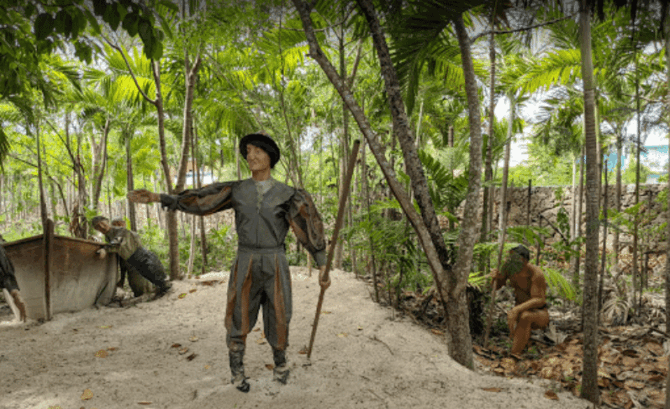The fishing village of Bayahibe is ideal for families who prefer a relaxing holiday, as well as for diving enthusiasts. The sea here is completely quiet, and right next to the shore there are small schools of fish. The clean beaches and blue waters of the Caribbean Sea attract tourists to nearby hotels.
Attractions Bayahibe on map
Parque del Este
Parque del Este or Cotubanama is an eastern national park located southeast of the Dominican Republic. Bayahibe Park has more than 500 species of flowers and 300 birds, as well as a long coastline where you can dive on coral reefs full of manatees, dolphins and other numerous sea creatures.
Parque del Este consists of three different climatic zones:
- rainforest;
- subtropical dry forest;
- mixed forests.
This made the park of the Dominican Republic an attractive place with lush vegetation. But in addition, Bayahibe Park is also known for its mysterious caves, decorated with symbols of local gods.
So, for example, in the park, namely in the guaraguao area, located almost on the coast, there are several ancient drawings on the rocks drawn by the population that lived here more than 500 years ago. And the underground humid Cueva de Chico is filled with a crystal clear freshwater spring, around which you can find more than 20 original Taino petroglyphs. In the remaining caves of Bayahibe Park there are many structures created by stalactites and stalagmites.
Another attraction in the park is mammal watching, this is one of the best places on the island where you can find almost all the local inhabitants. Among the many species that inhabit the area are the Dominican solerodon and hutia, which are threatened with extinction. As for the flora, the most numerous species of trees in the protected area of the park are:
- copies;
- copperwood;
- bayahonda;
- mahogany;
- Bullesia arboreal;
- coconut palm;
- sea grapes.
Also in the park you can visit the ecological and archaeological trail padre Nuestro. In this part of the park live 200 residents of Bayahibe, who are mainly engaged in fishing and tourism.
To make a trip to various parts of the park, whether it is a trail or islands, tourists must be accompanied by a licensed guide. The park’s own guides are available at both entrances to the park (from the Boca de Yuma side or from the Bayahibe side). Please note that there are no hotels in the park and camping is not permitted.
Saona island
Saona Island is a tropical island that lies near the southeastern edge of the Dominican Republic. The area of the island is 110 km2. The island belongs to the Protected Nature Reserve of Parque del Este. This part of the Eastern National Park is known for its mangroves, coral reefs and palm-lined beaches.
The water around the island is rich in wildlife: there are many species of birds, tropical marine fish and corals. The shallow waters of the island are also home to starfish.
The island is popular with tourists: small boats stop hundreds of meters from the beach and throw tourists into a shallow natural pool waist deep, where they swim and inspect the fields of starfish.
Catalina Island
One of the most famous offshore islands for scuba diving is Catalina, located south of La Romana. The reef of Catalina Island is suitable both for those who want to enjoy underwater views, and for those who simply enjoy the beaches.
The main beauty of Catalina Island lies in the surrounding coral reef ecosystem and its unique underwater ecosystem. On the island, you can snorkel among the endangered coral formations teeming with colorful reef fish.
After a scuba dive, head to the beach on the western side of Catalina Island for some rest and relaxation. It is a stunning place with its fine white sand, calm waters and lack of urban life on the island. Also, this part of the beach is used for excursions from the island on cruise ships.
Catalina Island is popular for its water sports, especially diving and snorkeling. The waters of Catalina Island are replete with coral reefs, as well as the “Living Museum of the Sea”. It opened three centuries after captain Kidd’s shipwreck right off the island.
El Chico Cave
The unique cave of El Chico is intended only for experienced divers. This is mainly due to the fact that there are no air cushions in the cave, and some tunnels are very narrow.
Although El Chico Cave is next to the road and residential buildings, finding a cave is not so easy. The entrance to the cave is a small pool at the foot of the rock, the font does not promise anything interesting and it is difficult to believe that there, behind its surface, something beautiful is hidden. Strange roots of tropical plants hang from the vaults of the grotto, adding even more mystery to the overall picture of the cave.
To dive into this cave, you need to have good preparation also because at the bottom there is a large layer of silt, more than half a meter. The slightest careless movement and visibility in the cave becomes zero.
The maximum depth of the cave is 12 meters, the total available length is about 120 meters. At the entrance, you need to lie down in a puddle 50 centimeters deep, roll over on your stomach and carefully crawl to a crevice in the rock. Immersed in crystal clear water, you can see a fairly wide entrance to the cave itself.
The first thing that catches your eye is the ceiling and bottom of the cave, where there are no traces of human presence. The first hall of the cave is located at a depth of 9 meters, surrounded by stalactites and stalagmites. Swimming deep into the cave through corridors with colonnades resembling ancient Greek temples, you will get into two huge halls. One of them presents a variety of stalactites and stalagmites covered with faceted crystals similar to diamonds. In the very center of the room there is a column resembling a medieval throne.
Multicolored rays of the sun make their way into the darkness of the cave through a crack in the rock. But, for additional consecration, it is better to take a flashlight with you.
Пещера Cave of Bridge
Cave of Bridge is one of the easily accessible caves in Cotubanama Park. Visiting the cave is free of charge (after paying the entrance ticket to the park). The path to the cave is about 3 kilometers, the walk to the cave takes from 45 minutes to 1 hour.
The cave is partially collapsed, forming a kind of natural bridge at the entrance, hence the name. The cave has a small number of Taino images, mostly depicting animals and humanoid figures that may represent humans or deities. Also in the cave there are stalactites, stalagmites and typical cave animals such as bats.
The cave is visited by small groups with a guide, there is no free access to it. To fully enjoy the walk and the cave, it is advisable to bring a flashlight, as well as trousers, a good T-shirt, sneakers and mosquito repellent.
Cigar Factory
Fine Cigars Bayahibe is a family cigar factory that develops its own lines of cigars. The factory was founded by Jean Michel and Katie, cigar lovers. It is also a shop that offers a wide selection of Dominican products.
A visit to the cigarette factory is not only a tour of the existing plant, but also an opportunity to enjoy cigars and rum. At the factory, tourists are offered a choice of handmade cigars made by experienced “torsedors”.
The cigar factory manufactures products exclusively from Dominican or Cuban tobacco grown on the island. To choose a cigar, the expert will help you find the right taste, as well as tell you how the cigar is made and what tastes and qualities Dominican cigars have.
A true connoisseur will also appreciate the quality rum, which will enhance the aroma of the cigar. During the tour, three varieties of rum aged from 10 to 20 years are introduced.
Finally, to complete the cigar and rum tasting, you will be asked to try chocolate made from real Dominican cocoa.
City of Artists Altos de Chavón
The City of Artists Altos de Chavón is a recreated Italian village of the sixteenth century, built in the late 70s as a cultural and entertainment center. The city of artists was designed by Dominican architect José Antonio Caro and built by Italian Roberto Coppa. It is made entirely of stone at a height of 30 meters above the Chavon River.
Today, the city of artists Altos de Chavón is a delightful place for excursions because of its medieval atmosphere, architecture, many cigar shops, clothing and jewelry, fine restaurants, bars and arts and crafts.
And perhaps the most charismatic structure of the city of artists Altos de Chavón is the impressive amphitheater. It was opened in 1982 by Frank Sinatra, and since then major world-famous artists have passed through it:
- Sting;
- Gloria Estefan;
- Shakira;
- Julio Iglesias;
- Duran Duran.
It is the main stage for shows and events in the country. The amphitheater is built of coral stone in the Greek style. Its dimensions are impressive, it holds 5,000 spectators.
The central part of the city of artists Altos de Chavón, the church of St. Stanislava, is a popular wedding venue in the Dominican Republic, with its unbeatable view of the river. In addition, the Archaeological Museum of the City of Artists of Altos de Chavón houses one of the most comprehensive collections of local culture in the Dominican Republic. Panoramic views of the Chavón River and the Dai For Golf Course, which borders on the east side, make the city of artists Altos de Chavón the perfect stop for photos while traveling around Beyahibe.
At night, the setting becomes even more magical thanks to the romantic lighting of the stone squares and dining verandas overlooking the river.
Garden labyrinth (Laberinto de las cueva de las maravillas)
In the archaeological site of the Garden labyrinth Laberinto de las cueva de las maravillas there is a labyrinth, with a length of 1632 meters. The garden labyrinth is located on the Eastern Highway, near the border between the provinces of La Romana and San Pedro de Macoris. Nearby, as a landmark, there are hotels Playa Nueva Romana.
The design of the labyrinth garden is inspired by the ancient labyrinths of Ireland and Scotland. Its construction is made of mesh covered with plants native to Southeast Asia. This plant is called caramon (tea from Fukin). The growth of trees in the laberinte garden took about two years.
A walk through the garden labyrinth lasts an average of about half an hour. Difficulties for the visitor arise at the exit, since, as the name suggests, this is a labyrinth. However, there is nothing to fear, as a tour of the labyrinth garden is accompanied by a guide who guides visitors to the exit and offers them help if they need it. The staff guarantees safety for visitors, even if someone gets confused, gets lost and cannot get out of the maze garden on their own.
The entrance to the labyrinth garden costs about $ 5 (the price is relevant for February [y]). Opening hours: Tuesday to Sunday and public holidays from 9:00 to 16:00.
Conquista Park
Conquista Park is the largest theme park in the Caribbean, dedicated to the discovery by Christopher Columbus of the first country of the New World and the first meeting with the indigenous civilization of the real Dominican Republic, the Taino Indians.
In 1492, Christopher Columbus discovered the coast of the Dominican Republic. And he decides to develop these territories, begins to manage them. The traveler builds the first cathedral of the island, the first university, the first hospital and, finally, the whole city of Santo Domingo. It is this story that is presented in detail in the park.
Conquista Park offers an exciting journey through time, in the heart of the peaceful village of Tainos, where Christopher Columbus will arrive in just 24 hours.
Conquista Park is included in many of the tours offered by Bayahibe hotels,
Website: http://www.conquistapark.com/
Bayahibe is a small and colorful fishing village with a good level of tourist infrastructure. Throughout the year, lovers of a relaxing holiday on paradise beaches, fans of deep-sea fishing and enthusiastic divers strive to get here. Bayahibe hotels will appeal to those who are looking for privacy, for example, couples in love, newlyweds.




















